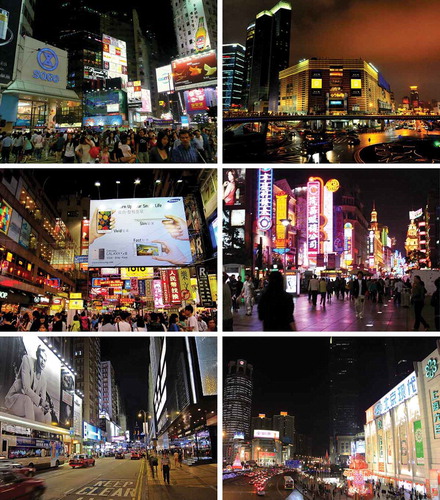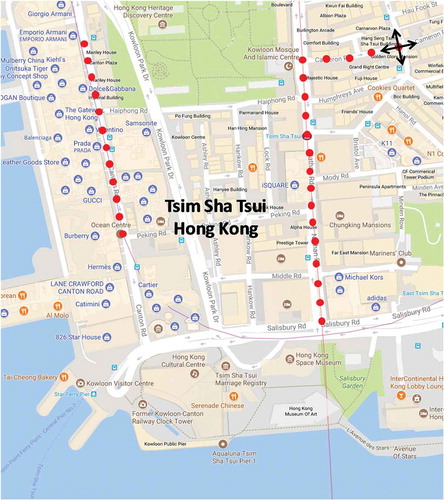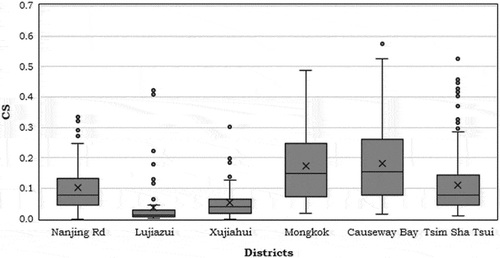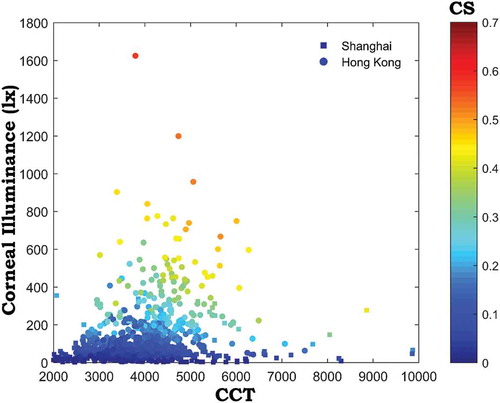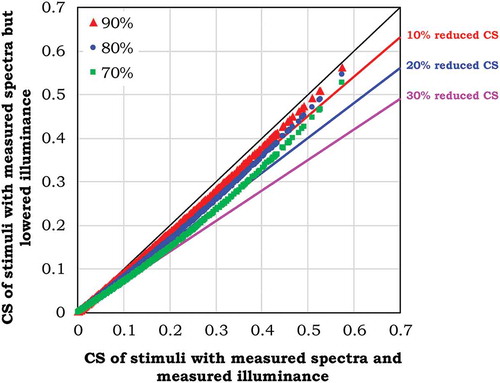ABSTRACT
Policymakers and standardization bodies have started to make recommendations about the use of lighting products at night, with the goal of reducing negative impacts on human health. We report a series of field measurements to quantify the responses of different human photoreceptors and the possible suppression of melatonin production caused by the exterior lighting in metropolises. In total, 888 spectral and 888 illuminance measurements were taken at 5.6 ft. above the ground in six commercial business districts, with three in Hong Kong and three in Shanghai. It was found that 47% and 86% of the measured light stimuli in Shanghai and Hong Kong may introduce suppression of melatonin production, as characterized using circadian stimulus (CS), because they had CS values beyond 0.05, a working threshold for acute melatonin suppression. In addition, both field measurements and computer simulations suggested that light stimuli with higher correlated color temperature (CCT) may not necessarily cause stronger melatonin suppression than those with lower CCT values.
KEYWORDS:
1. Introduction
Exterior lighting plays an important role in outdoor environments. It not only provides illumination to guarantee safety and security at night but also enhances a city’s beauty, creates a vibrant nightlife, and energizes the city. Different types of exterior lighting, such as road lighting, shop signs, advertisement boards, neon lights, façade lighting, and video walls, can be found in metropolises, especially in commercial business districts. When luminaires or installations are not well designed, exterior lighting may introduce sky glow, light trespass, and glare, causing complaints from drivers, pedestrians, residents, and environmental advocates. In Hong Kong, the government received more than 200 complaints related to external lighting every year. Illuminance, luminance, luminous intensity, threshold increment (TI), and upward light ratio are commonly specified in various standards to limit the negative impact of exterior lighting (CIE Citation2017).
Since the discovery of intrinsically photosensitive retinal ganglion cells (ipRGCs) in human retinas, optical radiation has been closely related to human health. Melanopsin, the photopigment in ipRGCs, and the action spectra for melatonin suppression in humans were found to have a strong sensitivity to optical radiation in the blue region of the visible spectrum (Berson et al. Citation2002; Brainard et al. Citation2001; Thapan et al. Citation2001).
In contrast to investigations on quantifying the possible influence of interior lighting on human health, few efforts have been made with regard to exterior lighting. We took a series of field measurements, including spectrum and illuminance, to estimate how exterior lighting in commercial business districts in metropolises may cause melatonin suppression and circadian disruption to pedestrians, which has not been documented previously. Six districts, with three in Hong Kong (that is, Causeway Bay, Mongkok, and Tsim Sha Tsui) and three in Shanghai (that is, Lujiazui, Nanjing Road Pedestrian Street, and Xujiahui), were selected. These districts are the major places of interest in these two metropolises with a great amount of exterior lighting, as shown in , and attract numerous tourists and local citizens at night. For example, 34.2% of tourists visited Tsim Sha Tsui and Mongkok and spent more than an hour in these districts (Hong Kong Transport Department Citation2014).
2. Methods
The measurements were taken at various points in each district, with a distance of 100 ft. between every two points. lists the number of measurement points in each district and shows the measurement points at Tsim Sha Tsui as an example. At each point, the measurements were taken in four directions (that is, two along the road and two perpendicular to the road), as illustrated in , on both sides of the road. A calibrated Everfine SFIM-300 spectral irradiance meter was placed vertically at an eye height of 5.6 ft. above the ground to measure the corneal illuminance and spectral power distribution (SPD), with an aim to capture the amount and spectral content of the light incident at a pedestrian’s cornea. All measurements were taken after 7:30 pm on non-rainy normal days to avoid daylight, additional exterior lighting for special events, and high reflections from wet building façades and ground. In total, 888 illuminance and 888 SPD measurements were taken (111 points × 4 directions × 2 sides).
Table 1. Number of measurement points at each district.
3. Results
Box plots of the corneal illuminance, together with the five α-opic irradiance values (that is, cyanopic irradiance, chloropic irradiance, erythropic irradiance, melonopic irradiance, and rhodopic irradiance) calculated for each measured stimulus to quantify the responses of the five human photoreceptors as suggested by the CIE (Citation2015), are shown in . It can be seen that the corneal illuminance values measured in Hong Kong were higher and had wider ranges than those in Shanghai, with an average of 164.57 lx in Hong Kong and 57.03 lx in Shanghai. Though no standards or guidelines have been developed for corneal illuminance, the maximum vertical illuminance of 25 lx for properties in commercial areas (that is, Environmental Lighting Zone E4), as specified in CIE 150:2017 (CIE Citation2017), can be taken as a reference. Furthermore, the light stimuli arriving at pedestrians’ eyes generally had chromaticities on or near the Planckian locus with correlated color temperature (CCT) levels between 2000 and 7000 K. As shown in , no relationship can be observed between illuminance and chromaticities.
Fig. 3. Box plots of measured corneal illuminance levels and the α-irradiance levels of the five photoreceptors in human retina for the stimuli in the six districts. (a) Corneal illuminance; (b) cyanopic irradiance; (c) chloropic irradiance; (d) erythropic irradiance; (e) melonopic irradiance; (f) rhodopic irradiance.

Fig. 4. Chromaticities, color labeled with the corneal illuminance, of each measured stimulus. (a) Shanghai and (b) Hong Kong.
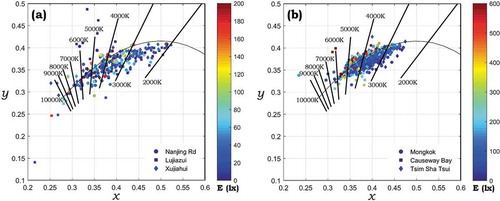
To characterize the possible effect of a stimulus on human’s melatonin suppression response, circadian stimulus (CS) was proposed by Rea et al. (Citation2010). It characterizes the possible melatonin suppression responses to a 1-h exposure to a light stimulus (Rea et al. Citation2010). Because a working threshold of 0.05 for acute nocturnal melatonin suppression has been proposed for CS (Rea and Figueiro Citation2013), we employed this metric to estimate the possible melatonin suppression in these commercial districts. As illustrated in , five of the six districts, with two in Shanghai and all three in Hong Kong, had an average CS value beyond 0.05. Specifically, 47% and 86% of the light stimuli measured in Shanghai and Hong Kong, respectively, as shown in and , had CS values beyond 0.05. (Note: Because pedestrians typically spend more than an hour in these districts, the threshold of 0.05 can be used directly.)
4. Discussion
Though many previous studies reported the significant impact of CCT on human physiology, including melatonin suppression (Brainard et al. Citation2015; Deguchi and Sato Citation1992; Ishibashi et al. Citation2007; Kozaki et al. Citation2005; Morita and Tokura Citation1998; Mukae and Sato Citation1992; Noguchi and Sakaguchi Citation1999), the data collected here did not suggest that a stimulus with a higher CCT necessarily caused a stronger melatonin suppression. As shown in , no obvious relationship can be observed between CCT and CS, which corroborated a previous SPD simulation study (Esposito and Houser Citation2016; Houser Citation2017). The low correlation between CCT and CS, however, does not necessarily mean that the significant impact of CCT found in previous studies was wrong. The sources used in these studies were either conventional light sources (for example, incandescent lamps, fluorescent lamps, and high-intensity discharge lamps) or blue-pumped light emitting diodes (LEDs) that were widely available on the market (Wei and Houser Citation2012). These types of light sources generally contain greater amounts of radiation in the short wavelength regions with an increase in CCT (Fotios and Yao Citation2018), which is very likely to simultaneously introduce greater impacts to human physiology. In contrast, the stimuli measured in this study were generally a mixture of multiple sources, so that the change in CCT may not cause a simultaneous change to CS.
More important, CCT is only a simple colorimetric quantity to characterize the general appearance of white light. Because it summarizes the amounts of radiation at different wavelengths across the visible spectrum into a single number, there are numerous ways to produce a light stimulus with a fixed CCT but different spectral contents. For example, we performed spectral optimization using a commercially available seven-channel LED lighting device to produce stimuli that have the lowest possible CS values but have the same chromaticities and illuminance as all the measured stimuli using a genetic algorithm (Wei and Chen Citation2018). (Note: to simulate more realistic installations, only four channels were allowed in the optimization.) shows a scatterplot of the CS values between the optimized and the measured SPDs for each chromaticity. It can be observed that the reduction in CS value caused by the light stimuli with optimized SPDs can be as high as 80%. Though LED lighting with a CCT of 3000 K or lower in outdoor installations was recommended by the American Medical Association (AMA Citation2016) to reduce the possible melatonin suppression caused by the strong short-wavelength optical radiation, which was supported by a series of measurements of commercially available LED products (Department of Energy Citation2018), the results presented in this study clearly suggest that the findings of these previous studies and the AMA’s recommendation may overgeneralize the effect of CCT on melatonin suppression.
Fig. 8. Comparison between the CS values of the stimuli with measured illuminance but optimized spectra and those of the stimuli with measured illuminance and measured spectra, which suggests the effectiveness of spectral tuning in reducing CS values. It also implies that stimuli with the same chromaticities (as well as the same CCT) can have large differences in CS.
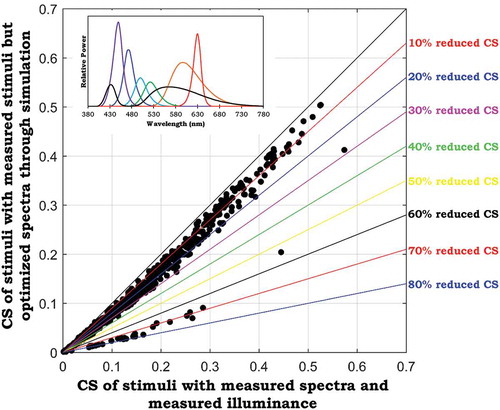
The corneal illuminance appeared to have a more direct impact on CS than CCT did, with a higher illuminance level for a higher CS value. The effect of illuminance on CS was further investigated by simply reducing the illuminance while keeping the spectrum unchanged for each stimulus. As shown in , the reductions in illuminance and CS values are not linear, though a lower illuminance can effectively reduce the CS value.
5. Conclusion
In short, a series of field measurements at six commercial business districts in two metropolises suggested that exterior lighting was likely to cause melatonin suppression among pedestrians at night. No strong correlation between CCT and possible melatonin suppression, as characterized using CS values, was found based on the measurements and spectral simulations, which could be due to the mixed stimuli in the measurements and the highly structured SPDs in the simulations. A series of spectral simulations suggested that light stimuli with optimized spectra may have a greater potential to reduce the negative impact of exterior lighting on human physiology.
Disclosure statement
The authors report no declarations of interest.
Additional information
Funding
References
- [AMA] American Medical Association. 2016. Human and environmental effects of light emitting diode (LED) community lighting. Report of the Council of Science and Public Health. Chicago (IL): American Medical Association.
- Berson DM, Dunn FA, Takao M. 2002. Phototransduction by retinal ganglion cells that set the circadian clock. Science. 295(5557):1070–73.
- Brainard GC, Hanifin JP, Greeson JM, Byrne B, Glickman G, Gerner E, Rollag MD. 2001. Action spectrum for melatonin regulation in humans: evidence for a novel circadian photoreceptor. J Neurosci. 21(16):6405–12.
- Brainard GC, Hanifin JP, Warfield B, Stone MK, James ME, Ayers M, Kubey A, Byrne B, Rollag M. 2015. Short wavelength enrichment of polychromatic light enhances human melatonin suppression potency. J Pineal Res. 58:352–61.
- [CIE] Commisssion Internatinoal de I’Edairage. 2015. CIE TN 003:2015 Report on the first international workshop on circadian and neurophysilogical photometry, 2013. Vienna (Austria): Commisssion Internatinoal de I’Edairage.
- [CIE] Commisssion Internatinoal de I’Edairage. 2017. CIE 150:2017 Guide on the limitation of the effects of obtrusive light from outdoor lighting installations. 2nd ed. Vienna (Austria): Commisssion Internatinoal de I’Edairage.
- Deguchi T, Sato M. 1992. The effect of color temperature of lighting sources on mental activity level. Ann Phyiol Anthrop. 11:37–43.
- [DOE] Department of Energy. 2018. Steet lighting and blue light – frequently asked questions. https://www.energy.gov/sites/prod/files/2017/02/f34/Street%20Lighting%20and%20Blue%20Light%20FAQs.pdf [ accessed Aug 28th 2018].
- Esposito T, Houser K. 2016. Realization and performance of an integrated therapeutic and architectural lighting solution. IES Light + Color Research Symposium III. April 3–5, 2016. Gaithersburg, MD.
- Fotios S, Yao Q. 2018. The association between correlated colour temperature and scotopic/photopic ratio. Lighting Res Tech. doi: 10.1177/1477153518779637
- Hong Kong Transport Department. 2014. Travel characterisitcs survey. http://www.td.gov.hk [ accessed May 5th 2018].
- Houser KW. 2017. The AMA’s misguided report on human and environmental effects of LED lighting. Leukos. 13(1):1–2.
- Ishibashi K, Kitamura S, Kozaki T, Yasukouchi A. 2007. Inhibition of heart rate variability during sleep in humans by 6700 K pre-sleep light exposure. J Physiol Anthropol Appl Human Sci. 26:39–43.
- Kozaki T, Kitamura S, Higashihara Y, Ishibashi K, Noguchi H, Yasukouchi A. 2005. Effect of color temperature of light sources on slow-wave sleep. J Physiol Anthropol Appl Human Sci. 24:183–86.
- Morita T, Tokura H. 1998. The influence of different wavelengths of light on human biological rhythms. Appl Hum Sci. 17:91–96.
- Mukae H, Sato M. 1992. The effect of color temperature of lighting sources on the autonomic nervous functions. Ann Physiol Anthrop. 1992(11):533–38.
- Noguchi H, Sakaguchi T. 1999. Effect of illuminance and color temperature on lowering of physiological activity. Appl Hum Sci. 18:117–23.
- Rea M, Figueiro M. 2013. A working threshold for acute nocturnal melatonin suppression from “white” light sources used in architectural applications. J Carcinog Mutagen. 4:150.
- Rea MS, Figueiro MG, Bierman A, Bullough JD. 2010. Circadian light. J Circadian Rhythms. 8(1):2.
- Thapan K, Arendt J, Skene DJ. 2001. An action spectrum for melatonin suppression: evidence for a novel non‐rod, non‐cone photoreceptor system in humans. J Physiol. 535(1):261–67.
- Wei M, Chen S. 2018. Impact of spectral power distribution of daylight simulators on whiteness specification for surface colors. Color Res Appl. 43:27–33.
- Wei M, Houser KW. 2012. Status of solid-state lighting based on entries to the 2010 US DOE Next Generation Luminaire competition. Leukos. 8(4):237–59.

